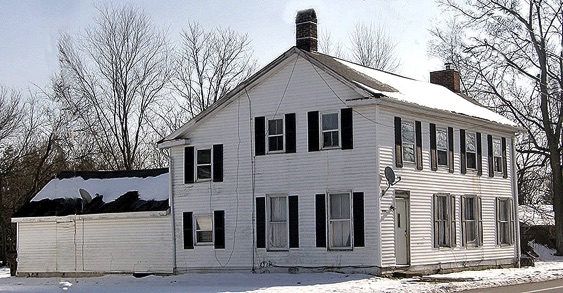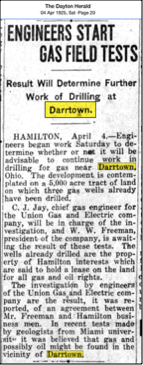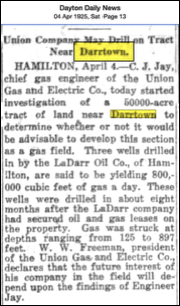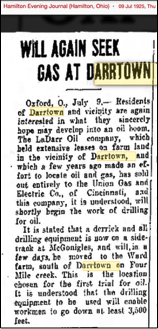
RESEARCH
Webmaster Note: Following an exchange of information, Mr. Woodward provided the following copies of three letters that are related to the Darr Gas and Oil Company. We are indebted to Mr. Woodward for his willingness to share the following, as it enriches the history of Darrtown.

BUSINESSES 6
Milford House background
Until mid-November 2012, the management of this website had not discovered or received any information regarding a "Milford House" in Darrtown, Ohio. Then, on November 18, 2012, Mr. Kim Johnson sent an email message that included a black and white image (see below) that displays a group of people gathered around a framed structure.

By enlarging the above image, it is revealed that the sign that stands in front of this structure reads "Milford House." The name of this establishment was likely taken from Milford Township, which is home to Darrtown.
Lettering, along the bottom edge of the sign, begins with the initials of a person named Flenner. The initials appear to be "C.B" or "C.H." or "G.R."
Ancestry.com records show that George Rudolph Flenner lived in Darrtown, during the mid-1800s. So, the name is probably "G.R. Flenner."
Several persons who are familiar with Darrtown structures recognize the Milford House (seen in the black and white photograph) as being the residence that stands on the east side of Main Street, just south of the Milford Township Fire House. That building has distinctive windows and eaves that make it easy to match with the old photograph.
The following image of the existing structure, located at 4294 Hamilton Richmond Road, was taken in January 2013.


During a January 5, 2012 telephone conversation, Mr. and Mrs. George and Fay (Bufler) Thome confirmed that they lived at this location for 35 years (from 1951 to 1986).
Fay and George Thome described the following features of this property:
> Windows that extended to the floor of the front rooms
> Two doors at the corner of the northwest room of the house (these are visible in the black and white photograph - above).
> One of the two doors was located the north wall and one was located in the west wall.
> The north door has since been converted to a (shortened) window.
> A wood surface on the west wall of the northwest room; which is believed to have been the tavern's bar area.
> Exterior stairs at the rear of the house, which allowed access/egress to and from the second floor.
> The exterior stairs were presumed to be essential for a house that served as a boarding house.
Fay Thome also reported that, at one time - before the Thome family lived at this location - a Mrs. Witherby lived in the front part of the house. This Mrs. Witherby was the mother of Albert Witherby, who lived in Darrtown, at 3010 Scott Road, during the 1950s and 1960s.
In July 2015, interest in the story of the Darr Gas and Oil Company was rekindled, when Mr. Clifford Woodward, of Glenshaw, Pennsylvania, emailed an inquiry to the Darrtown webmaster (click link at the right to see the email).
Letter #1 Transcription:
Fosters, OH
August 20, 1901
Fosters Ohio - Aug 20th
Mr. G.H. Hentchler,
Dear Sir
I saw in the Lebanon Record that you were Pres of a Co that was going to bore for oil and gass in Hamilton O. there has been talk of oil here for a number of years and a Co was formed at Maineville (2 miles from here) two years ago but they are so slow they have done nothing yet. there is a salt spring there where my father watched the indians boil salt water for salt, 80 yrs ago, he was 10 year old at the time; and there is another salt spring right near our farm, there are 500 acres owned by 3 parties here that you could make arrangements with, beside plenty of other land, we have timber on the place you can use, and we could board some of the men if necessary. would like you to come and see the place if we don't hear from you in 10 days will consult other parties call on or address.
Dexter Tufts
Fosters, Warren Co., O.
Letter #2 Transcription: Darrtown, OH
September 1, 1901
Darrtown O. - Sept 1 01
Received of L.P. Clawson - Twenty Dollars, being 10% assessment on two shares of stock in the Darrtown Gas Co.
L.P. Clawson
Acting Treas.
Letter #3 Transcription: Darrtown, OH
September 20, 1901
Darrtown O. - Sept 20/01
Mr. G.A. Reutschler,
Hamilton, O.
Dear Sir:
Enclosed you will find scripts to sign and send up to the Bank. I presume Mr. Schwab told you that he thought it best to make another assessment. We are about 800 feet deep and are still in the Trenton Rock and it looks like it may be several days before we get through it. Will telephone you if anything important turns up.
Very Respectfully,
Frank W Clements
Webmaster Note: In the documents above, presumably, the names spelled as "Hentchler" in Letter #1 and "Reutschler" in Letter #2 are misspellings of "Rentschler," which is a name that appears in the 1901 news article above and is a long-standing name in the Hamilton, Ohio legal and business world.
√
The next year (1923 - June 1st), an oil strike at the Mee farm, one mile west of Darrtown. was reported by a local newspaper. The links at the right tell the story.
A dictionary defines "succor" as "assistance and support in times of hardship and distress."
Going west out of Darrtown, on the Schollenbarger Road, the Mee farm ("1 mi. west of Darrtown") was located on the north side of the road, at the point where it curves around the northwest corner of the Darrtown cemetery and continues southward.
In his diaries, Mr. Miller frequently referred to the Four Mile Creek as the "Talawanda River."
The Four Mile Creek runs under the bridge on St. Rt. 177, about one-half mile south of Darrtown.


BUSINESSES 2. The Hitching Post (plus, links to Darrtown/Milford township tavern history).
"That reminds me of the old Darr Gas and Oil Company. In 1921, Frank Sloat, he was a Hamilton resident, got interested in the gas that was seeping up through Four Mile Creek. You could see these bubbles coming up. Frank, he would take a five gallon can, cut the bottom out of it, light the gas, and the flames would rise two or three feet high. So the Darr Gas and Oil Company was formed with local money out of Hamilton. It incorporated, by subscription, for $100,000. My father was one of the directors and contributed a little money towards it. They employed a driller from Kentucky. He had a portable rig, powered by a steam boiler. The first well was drilled in 1922 on one of our farms across the road from the Darrtown cemetery. They found gas at about four hundred feet. They used the gas from this well, instead of a coal-fired boiler, and moved to well number two, which was about fifty feet north and drilled about fourteen hundred feet. They used the gas from the shallow well for the boiler to propel the rig for the second well. They found a lot of low-pressure gas. Then, they moved about two thousand feet north, up on more or less rolling ground, still on one of our farms, and went down about 750 feet. When they brought the well in, they usually hired somebody else to spring the well in. Not the local drillers; and the guy that brought the well in used twenty-five quarts of nitroglycerin, which was way too much. It just blew up the casing and ruined the well. They always figured that guy was paid off to put the company out of business. But in 1925, the first two wells were connected together. They had all this casing left over that was piled up for several years. So my father went out to Terre Haute, Indiana to some gas supply company and made a deal where he traded them this eight-inch casing for two-inch pipe. It's about two miles from this well down to the big house. And the house was piped for gas. We used that, until my dad died in 1948. The gas was piped into the furnaces, four fireplaces and the burners in each of the bedrooms upstairs. Periodically, we would have the water bailed out of those wells, because it was low-pressure. We had to put a compressor in one of the buildings there to bring the gas in. It wasn't very dependable. In the winter time, I would come home and mother would say the gas was off. I would have to take a couple of pipe wrenches and start running the line back. The gas line was on the surface of the ground and at every contour of the ground there would be a drain plug at the lowest level. The gas wasn't strong enough to push through the water and the moisture would collect and then if that damn thing would freeze, you didn't know when you'd have gas again. I could always tell where the problem was because I could hear the flow of gas. Sometimes I would have to walk the complete line and sometimes I would get by and only have to walk half. It seemed like, in the spring of the year, when the farmers would start plowing and open up the soil, the gas would get low until we would get a good rain. Then it would seal the ground and we would have more pressure then."
The search for natural gas in the Darrtown area, during the early 1920s, is addressed in excerpted memories of R. Kirk Mee II (click the link at the right). To see Mr. Mee's entire set of recollections, visit: R. Kirk Mee Recollections.
Dear Sirs, I have been researching some letters written in September and October of 1901 (from Darrtown and Fosters, Ohio) that reference the "Darrtown Gas Co." and an individual by the name of Frank W. Clements representing the company and an oil well that was being drilled. I would be very interested in knowing if there is a history of oil and gas production in your area, and if there is any history extant for this company. My interest is in the petroleum history of Pennsylvania, New York, Ohio and West Virginia; I collect ephemera and historical documents related to this area. Any insight you could provide would be most appreciated. Thanks for your time and consideration. Clifford W. Woodward
Kirk Mee's 1920 memories (above) mirror a similar enterprise that was undertaken some 20 years earlier, when local entrepreneurs attempted to harness the resource (click the link at the right). The original source is the Hamilton Daily Republican News - August 2, 1901 - page 5, and it confirms the earliest known gas or oil business venture, near Darrtown.
"1901_1 - Drilling for Gas Begins at Darrtown BEGIN BORING TUESDAY Gas Promoters Push Their Work at Darrtown Derrick in Place on the Nichols Farm George H. Scott in the City Today The derrick on the farm of J. W. Nichol, near Darrtown, is now finished and in place, the engines in position and everything is in readiness for the beginning of operations, except for putting in the drills, which will be done at once. Drilling will begin Tuesday afternoon. George H. Scott of the firm Scott and Ball, of Muncie, Indiana, was in the city today and all arrangements for the active work of development were completed and the work will be pushed as rapidly as possible. The company is composed of George Rentschler, president; Peter Schwab, vice-president; L. P. Clawson, secretary and treasurer; and three officers with J. W. Nichol and Gottlieb Wagonfield constitute the board of directors. The company has opened an office in Darrtown with Frank W. Clements in charge and everything is now in fine business shape."

THE FOLLOWING EXCERPTS FROM L.A. MILLER'S DIARIES DESCRIBE THE HUNT FOR GAS OR OIL AT DARRTOWN





The Dayton Herald – April 4, 1925 – page 20 ENGINEERS START FIELD TESTS Result will Determine Further Work of Drilling at Darrtown “Hamilton, April 4 – Engineers began work Saturday to determine whether or not it will be advisable to continue work in drilling for gas near Darrtown, Ohio. The development is contemplated on a 5,000-acre tract of land on which three gas wells already have been drilled. C.J. Jay, gas engineer for the Union Gas and Electric company, will be in charge of the investigation and W. W. Freeman, president of the company, is awaiting the result of these tests. The wells already drilled are the property of Hamilton interests which are said to hold a lease on the land for all gas and oil rights. The investigation by engineers of the Union Gas and Electric company are the result, it was reported, of an agreement between Mr. Freeman and Hamilton business men. In recent tests, made by geologists from Miami University, it was believed that gas and possibly oil might be found in the vicinity of Darrtown.”
Hamilton Evening Journal - April 4, 1925, page 11 TESTS FOR GAS WELLS To Be Made Near Darrtown by U. G. & E. Engineers Soon “In accordance with an arrangement made several months ago, engineers for the Union Gas and Electric company of Cincinnati, are planning to make an investigation to determine whether or not gas is to be found in land holdings near Darrtown. The agreement to make such an investigation and to drill wells testing the possibilities for the drilling for gas was made between Union Gas and Electric company officials and Hamilton men who are interested in the LaDarr company. This company holds a lease on approximately 5,000 acres of land near Darrtown, it was reported. Gas wells already drilled on the land indicate, it is said, that there are large gas fields from which an enormous supply of natural gas may be obtained. Professors in the geology department at Miami University have made a number of surveys on the field and have stated at various periods, that gas and oil may be found in that vicinity. W. W. Freeman, president of the Union Gas & Electric company, of Cincinnati, stated today that there are no new developments and that, as yet, engineers of the company have not made great headway in an investigation. With the coming of summer, the work will be advanced.” WEBMASTER NOTE: This article cites the “Hamilton men who are interested in the LaDarr company.” Presumably, this verifies that LaDarr was the official name of the Darrtown business.
=====================
1922
June 6: ...Oil people have organized a Co-Op. Stock $100. They are now wanting for succors to invest, I presume. They string a lot of succors on the oil leases around this burg of Darrtown.
=====================
1923
May 21: ...The LeDarr Oil Co. has its drilling rig at McGonigle and Oxford O. and are now hauling same to the "Mee" farm 1 mi. west of Darrtown.
May 23: The LeDarr Oil Co. are (sic) getting their drilling rigs for the ground near the Darrtown cemetery one mile west of Darrtown on the old Sample farm, afterwards owned by David Schollenbarger and now owned by the John F. Mee estates.
May 25: ...Drillers for oil company expect to be starting drill by Monday of next week.
June 2: ...I called at various place in town on biz and otherwise. The talk is Gas and Oil …
June 18: ...Oil men have had to pull casing and abandon well at about 200 feet. Bad casing buckled on them. Will use gas of abandoned well. Well shut down until they get right kind of casing.
July 9: ...The LeDarr Oil Co. is having bad luck getting a casing. They have done nothing now for two weeks.
Aug. 22: ... The drillers are putting down a well for oil one mile west of here and have had some bad luck – lost a drill, but have recovered it and are now going ahead.
=====================
1925
Apr. 2: … Some prospect of drilling for oil in the Darrtown territory this summer by the Crown [?] Gas and Electric Company of West Va.
Oct. 13: … Drillers for gas and oil are still at it. No oil – but, some gas has been struck. Darrtown real estate is in good demand; but few sales. No one cares to let loose just now.
Dec. 7: … Drillers for gas and oil are pegging away and having all kinds of trouble with casing – out of water and 1,400 feet. Drill rig located on bank of Talawanda R. ½ mile from my office – in sight.
Dayton Daily News – April 4, 1925 – page 13 Union Company Made Drill on Tract Near Darrtown C. J. Jay, chief gas engineer of the Union Gas and Electric Company, today started investigation of a 50,000-acre tract of land* near Darrtown to determine whether or not it would be advisable to develop this section as a gas field. Three wells drilled in by the LaDarr Oil Company, of Hamilton, are said to be yielding 800,000 cubic feet a day. These wells were drilled in about eight months, after the LaDarr company had secured oil and gas leases on the property. Gas was struck at depths ranging from 125 to 897 feet. W. W. Freeman, president of the Union, Gas and Electric Company, declares that the future interest of his company in the field will depend on the findings of Engineer Jay. *Webmaster Note: The reported 50,000-acre tract of land (in the first sentence above) is likely a typographical error. One section of Milford Township equals 640 acres. There are 36 sections in Milford Township, which means that there are 23,040 acres in all of Milford Township, which is far short of 50,000 acres.
Hamilton Evening Journal (Hamilton, Ohio) July 9, 1925 Will again seek gas at Darrtown “Oxford, Ohio, July 9 – Residents of Darrtown and vicinity are again interested in what they sincerely hope may develop into an oil boom. The LaDarr Oil company, which held extensive leases on farmland in the vicinity of Darrtown, and which a few years ago made an effort to locate oil and gas, has sold out entirely to the Union Gas and Electric Co., of Cincinnati, and this company, it is understood, will shortly begin the work of drilling for oil. It is stated that a derrick and all drilling equipment is now on a sidetrack at McGonigle, and will, in a few days, be moved to the Ward farm, south of Darrtown on Four Mile Creek. This is the location chosen for the first trial for oil. It is understood that the drilling equipment to be used will enable workmen to go down at least 3,500 feet.”
Documentation (in the form of newspaper accounts, written communications, and personal diaries/recollections) confirms that, in the early 1900s, numerous efforts were made to find natural gas and/or oil at various locations, near Darrtown.
Newspaper items, about the hunt for oil and gas fields at Darrtown, appeared from 1901 through 1925.
The hunt produced results. One newspaper account reported an output of 800,000 cubic feet of gas, per day.
Five specific locations have been identified:
(1) The J.W. Nichol farm, south of Darrtown, on the east side of Darrtown Pike.
(2) The Charles Ward farm, south of Darrtown, on the west side of Darrtown Road.
(3) The Mee farm, west of Darrtown, on the north side of Schollenbarger Road, at the Darrtown cemetery;
(4) The R. Kirk Mee farm and house at the north edge of Darrtown, on the west side of Darrtown Pike.
(5) The Clement "Clem" Pfaff farm that straddled Darrtown Pike, about two miles north of Darrtown.



LEFT:
This 1894 news item reports a community event that was held "at the "gas springs near Darrtown." Described as a "social gathering," it is obvious that people knew about the presence of natural gas in the Darrtown area, before the turn of the 20th century.
At this time (February, 2024), reseach has not revealed any documented attempt to harness the natural gas for commercial gain - prior to 1901.
Using today's vernacular, one might describe this event as "TAILGATING...1894 STYLE"
In 1925, multiple stories appeared in area newspapers about drilling for oil and gas in the Darrtown area. Images of four such stories appear below. Click the LINKS BELOW the images to see them enlarged.
TO SEE ALL OF L.A. MILLER'S DIARIES, VISIT: Miller Diaries - background




Check out a graphic that illustrates the apparent thought process behind this "social gathering."
The numerals in the list above correspond to the numerals that appear on the map that is available at the link at the right.
In 1902 (April), the Richmond (Indiana) Item published an article that reported more gas-seeking activity.
"The Richmond item – April 11, 1902 – page 1. NATURAL GAS NEAR DARRTOWN The exploration for natural gas in the vicinity of Darrtown is to be prosecuted with greater vigor than ever in the near future. The well is now down about 1,620 feet and the last report of the drillers was that they had struck Trenton rock. This indicates gas or oil producing strata and, if it proves true, will considerably revolutionize geological ideas in Ohio. The company, the Darrtown Gas Co., now proposes and will make the test to the full limit and expect to drill down to depth of at least 3,000 feet. If there is oil or gas in this vicinity, they intend to find it."
The Journal News – June 1, 1923 – page 16 Heavy Gas Flow Near Darrtown Well To Go Deeper LeDarr Oil and Gas Company to Ignore Strike at Present Gas was struck at 130 feet in the first well drilled by the LeDarr Oil and Gas Company on the Mee farm one mile west of Darrtown Thursday. The flow was estimated at 150,000 to 200,000 cubic feet a day. The gas flowed through the 10-inch casing, with considerable pressure and gave evidence of being a permanent flow. Last night, the gas was piped away from the rigging and lighted. Hundreds of people visited the scene and witnessed the spectacle, as the large gas flow was consumed in a brilliant blaze. Today, additional casing was to be driven down into the well to shut out the gas, so that drilling may proceed. By driving down the casing, it is extended past the strata from which the gas has been flowing. Thus, the work will continue without danger of asphyxiation or fire. The gas flow already struck will be ignored for the present time. Persons familiar with gas and oil drilling operations were jubilant after the first strike. The heavy gas flow was interpreted as an encouraging sign. The LeDarr Oil and Gas company has been quietly working for some time on the well. The rigging was erected and drilling started by N. F. Hughes, drilling contractor, Gibsonburg. A carload of coal and 1,000 feet of casing are on the site. Two crews of men are at work, so that the drilling proceeds 24 hours a day. F. Sloat is president of the LeDarr Oil and Gas company which maintains headquarters in the Rentschler building.
"Members of the most respected families in the community were tavern keepers; Aaron Chamberlain, Stephen Kendall, and William Kirkpatrick kept taverns here in later years." [Source: this website; see HIstory/Early History / 1817 Hitching Post opens]
"William Kirkpatrick, born August 17, 1814 and died June 27, 1848, (possibly Jane's brother or nephew), married Mary Magdalena Flenner on May 5, 1838. She was on born December 27, 1819 and died December 5, 1905. She was better known as Polly. They owned a tavern in Darrtown." [Source: this website; see People / Families / Harris Family]
"William Kirkpatrick kept a tavern in Darrtown in 1845 in the house now occupied by his son Samuel as a tavern and saloon." [Source: Butler County OHGenWeb Project page / Milford Township:pages 562-574]
Historical documents reveal the following tidbits about this historic structure:
An 1902 (August), news item in the Journal News of Hamilton, Ohio reported on the "Oil Quest Progress."
The Journal News – Hamilton, - August 19, 1922 – page 1 Darrtown Oil Quest Progress Preliminary work on the LaDarr Oil and Gas Company’s gas well operations near Darrtown is nearly completed, F. J. J. Sloat, one of the officials of the company, said this morning. From the geologist’s report, and from other available indications, Mr. Sloat believes that the drilling will be “worth the effort.” The LaDarr company has been working in the Darrtown field for some time.
An additional piece of information about natural gas at Darrtown, unrelated to seeking commercial gain, has been found. The 1894 newspaper article, published by the Hamilton Evening Journal, appears below.

Click the following links to see a reprint of an 1889 news clipping (and a transcription of the same) which describes how some "paraies" (parties?) used the natural gas at Darrtown for amusement.
The Lima (Ohio) News – May 15, 1889 – page 4 “At a point near Darrtown, Ohio, a village, eight miles west of Hamilton, a flow of natural gas has been discovered in a creek nearby. The gas bubbles up through the water and escapes in the air. Parties amuse themselves by lighting paper and, with a long pole, hold it over the point at which the gas escapes and are rewarded with quite a blaze. A number of citizens from Hamilton have visited the point and an effort will be made to sink a well in the neighborhood and test the flow of gas.”
The presence of natural gas in the Darrtown area has been documented by various newspaper accounts and personal journals - as demonstrated by exhibits below.
Future research may produce information that alters the story of natural gas at Darrtown; however, for the time being(June 2024), the story is organized and presented in two phases:
▶︎ Phase One: The Novelty Phase (discovery, curiosity, and amusement)
▶︎ Phase Two: The Commercialization Phase (attempts to harness the gas for financial gain)
The following links reveal a reprint of an 1892 newspaper item (and a transcription of the same) that reports the sighting of rising gas bubbles in the Four Mile Creek, west of Darrtown, near Lane's Mill.
Joe Bufler, of Darrtown, is named as one who capped the rising bubbles and used a lighted match to produce a flame. The spot in the creek is described as a "gas pocket" and is reported to have been "visited by hundreds of people."
Hamilton Evening Journal - August 6, 1892 - page 4 The natural gas which has, for years, been escaping in Four Mile Creek, near Wm. Lane’s Mill is increasing in strength. It can plainly be seen from the bank of the creek, as it makes the water boil in a space twenty feet square; this gas has been escaping for the past twenty-two years. About three years ago, Joe Bufler, Darrtown, thought he would satisfy the minds of the people in the neighborhood, so he sank a large barrel in the creek, directly over the largest vein and bored a hole in the top of the barrel; he put a lighted match to the hole and a flame three feet high shot up. This place has been visited by hundreds of people and several scientific men who have visited the locality say the gas escapes from a strong supply through a small passageway in the earth, the depth of which is not known. It is supposed that this crevice is wearing larger, hence the smell will be more perceptible. It is strange no one has the energy to develop this neighborhood, as there is surely gas in abundance.
The above image is an example of gas bubbles in water. Imagine seeing an area of bubbles that measured approximately four feet by five feet (i.e. - 20 square feet), as reported in the news article.
Sometime in the early 1900s, a few individuals got serious about investigating the amount of natural gas that was available and whether it could be harnessed for financial gain. The following items document known search efforts, spanning the years 1901-1925. Current research indicates that the LaDarr Oil and Gas Company was the primary commercial force behind the search effort.


BUSINESSES 1. Reeb's store; Bufler's grocery, another Bufler store; Stevens' grocery, Francis' gas station, Wyckoff's grocery; Dees grocery and gas station; Glardon's grocery; and Don's Carry-Out.
